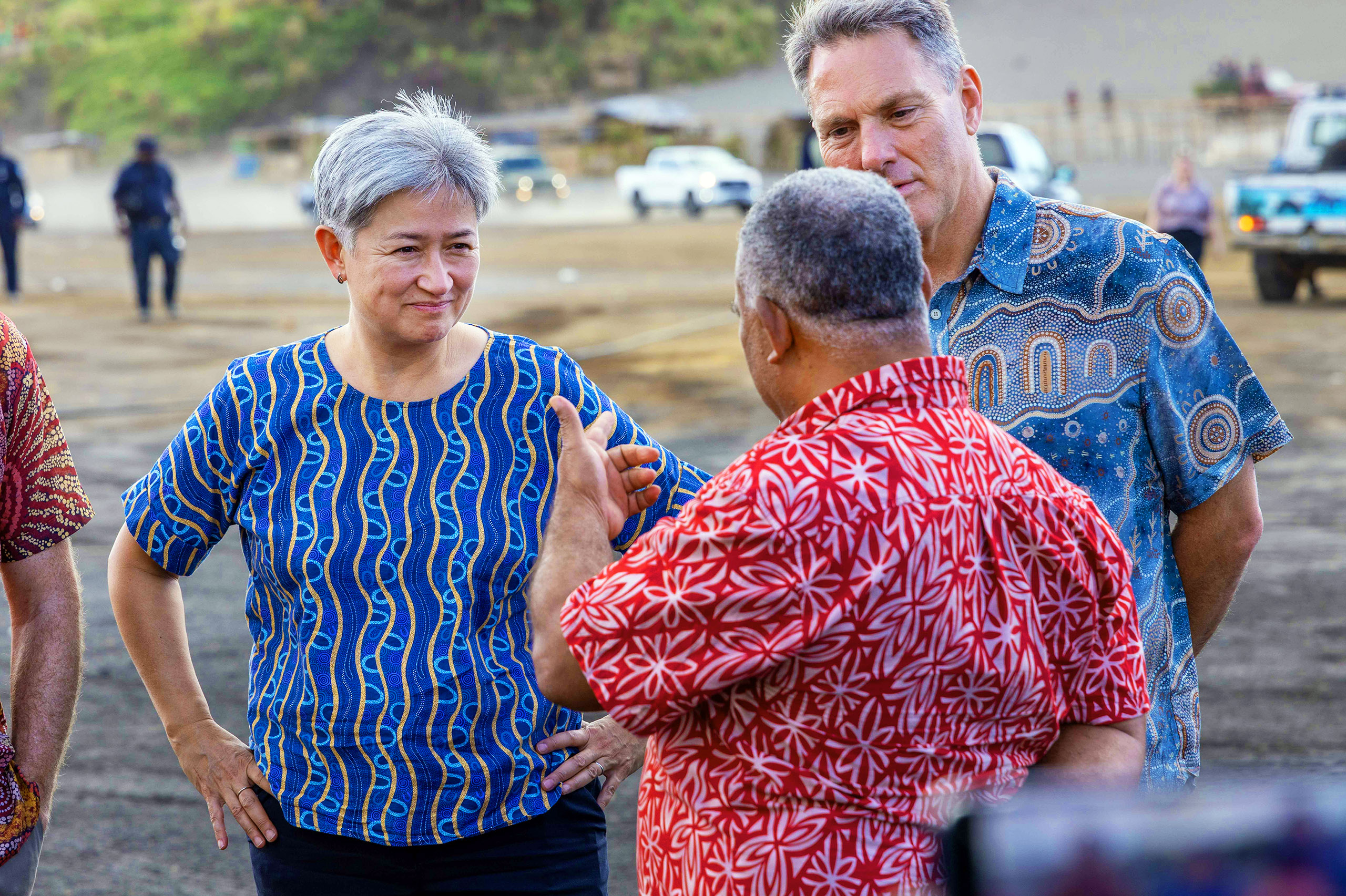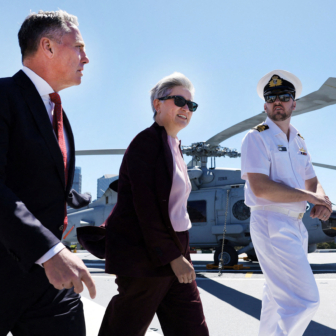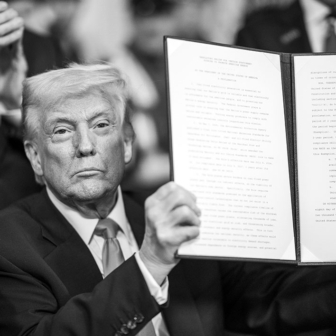Faced with the inevitable wrangling between Chinese foreign minister Wang Yi and US secretary of state Marco Rubio at the Pacific Islands Forum summit next month, Solomon Islands prime minister Jeremiah Manele has decided that neither they nor some eighteen other outside partners and aid donors will be allowed to attend the gathering as observers.
In some countries, Manele’s decision has been portrayed as ingratitude — even in Australia and New Zealand, forum members that will each have a seat at the leaders’ table. But the Honiara jeremiad might be getting rueful sympathy from a wider selection of bigger countries on this side of the Pacific. Great power competition no longer seems to be working to the benefit of the countries of East Asia — Japan, South Korea and Taiwan — or the ten members of the Association of Southeast Asian Nations, or even Australia and New Zealand themselves.
Instead, they have been singled out for erratic treatment, and punishment, since Donald Trump’s was first elected to the White House nearly a decade ago, punctuated by the Joe Biden interlude. Constant admonishments from Washington have demanded more defence spending and explicit opposition to China, regardless of trade links and likely retaliation by Beijing.
In Australia’s case, the government has responded by stepping up engagement with Asia, providing more security-linked aid in the Pacific, engaging in more big-talking and cheque-writing in defence, and maintaining a head-below-the-parapet stance towards Washington. (Except for occasional placatory gestures, like Aztec priests throwing sacrifices into the volcano, that have so far included a lifting of a longrunning ban on US beef and two US$500 million contributions to American submarine yards.)
For all countries in the region, Trump’s most shocking move has been the removal of mostly low-tariff, quota-free access to the rich American market, with no exceptions for friends and allies. This month’s anniversary of the end of the second world war is a reminder that access to American consumers helped Japan rebuild after its wartime devastation, moving from manufacturing toys and gadgets to transistor radios and then from motorbikes and video-cassette recorders to cars and computers. Behind Japan came the Asian “tigers” — Korea, Taiwan and Singapore — followed by a wider array of manufacture exports from Malaysia, Indonesia, Thailand and Vietnam.
Until recently, American elites saw this trade as a strategic gain, creating robust capitalist economies and eventually more prosperous markets for US products. America adapted, with its carmakers building regional factories into their supply chains and bringing smaller Asian-designed cars into their ranges. If Japan and others supplied hardware like television sets and VCRs, the real money was in the content that played on them, and that was made in Hollywood. More revolutions came out of America: mobile phones and wi-fi, advanced pharmaceuticals, geospatial systems, electric cars, AI. America’s deficit in the goods trade was increasingly counterbalanced by a surplus in services.
Now Trump is playing to pushed-aside American blue-collar workers (many of them now past retirement age) with dreams of bringing back car and steel production and manufacturing and assembling semiconductors and mobile devices. Japan, South Korea and New Zealand have been hit with 15 per cent tariffs, Taiwan and Vietnam with 20 per cent, Thailand, the Philippines and Indonesia with 19 per cent. Whether it stimulates US domestic industry enough to warrant the price effects for American consumers remains to be seen.
The region’s leaders have had to tell their people this was the best they can get, in many cases after pleading with Trump and accepting wildly ambitious demands in return. Malaysia’s Anwar Ibrahim agreed to invest US$70 billion in America. After the meeting with Japan’s Shigeru Ishiba on 22 July, the White House announced Japan would invest US$550 billion in US industry and facilitate new imports of US cars, farm produce, aircraft and liquified natural gas.
Japanese officials later clarified that the investments would be made by Japanese businesses on normal commercial terms, and it can be assumed that many of the promised imports would have been made anyway. (American-model cars are unlikely to be seen much in Japan’s narrow streets, where they have cachet mainly among yakuza bosses and film stars.) “Japan has been playing rope-a-dope on trade commitments for fifty years,” says John Berthelson, publisher of Asia Sentinel. “I’ll believe it when I see it.”
The reaction in Japan has nonetheless been furious. “It’s nothing but an outrageous act that will destroy the post–World War II international economic order,” editorialised the mass circulation Mainichi Shimbun. In the Asahi Shimbun, veteran Washington correspondent and economics professor Kensuke Karube likened Trump to a chimpira, a protection racketeer. “[Tariffs have] become a bargaining chip in Trump-style deals, sometimes like violent thuggish shakedowns, to achieve various US policy objectives,” he commented.
It’s not just an economic strategy, agrees Vietnamese-Canadian lawyer and commentator Khanh Vu Duc. “It is a [wider] strategy cloaked in tariffs,” he wrote early this month in Asia Sentinel. As well as demanding zero-tariff access for US exports in return for lower-than-threatened access, Trump demanded rules of origin and trans-shipment disclosure, especially to block Chinese rerouting of exports through third-party nations, and alignment with his security objectives. It was all designed to isolate China.
“What we are witnessing is the birth of a Transactional Order, a system where access to the US economy is conditional upon political alignment and economic reciprocity,” says Duc. “Trump’s deals signal an end to the postwar liberal order anchored by the World Trade Organization, and a transition to an American-centric hub-and-spoke system where power, not principle, dictates terms.”
It has a certain logic, he adds. “It rewards loyalty, punishes opportunism, and leverages America’s economic gravity to enforce strategic discipline. For countries like Vietnam, Indonesia, the Philippines, and even parts of the EU, it offers a path to security and prosperity, provided they accept American rules of engagement.”
The examples of Brazil (hit with 50 per cent tariffs for not calling off its prosecution of ex-president Jair Bolsanaro), India (threatened with 50 per cent for buying Russian oil) and Canada (35 per cent for being, well, defiantly Canadian) hover as the sort of club Trump is prepared to wield. Along with the tariffs come public insults. Modi was stung by Trump’s comment that he ran a “dead economy” (India has been the fastest-growing big economy in recent years), an insult that has driven a truck through the Quad strategic alignment of India with the United States, Japan and Australia.
As well as the economic hit, Trump is removing much of the other support coming out of America. Well-off families will worry about the quality of education in the universities he is shaking down, and whether they and their children could get caught up in a capricious and punitive immigration system. His dismantling of the US Agency for International Development removes well-appreciated aid programs in the poorer parts of the region.
Trump’s heath secretary, Robert F. Kennedy, has just removed US$500 million in government support for mRNA vaccines, which played a huge part in quelling Covid-19 in Asia and elsewhere. USAID assistance to the South Pacific was relatively small (about US$1.4 billion over 2009–22) but considered effective. One focus in Papua New Guinea, for example, was public health; lapsing vaccinations there have just led to a new outbreak of polio.
“Trump is an example of the dangers faced by a country when its leader is ignorant and uneducated,” writes author and mathematician Masahiko Fujiwara in the current issue of the monthly Bungei Shunju. “It was the high quality of American university research that turned the US into a first-rate country. Trump seems totally unaware of this and behaves like the Chinese emperor who burned books and buried scholars alive.”
Many of Trump’s threats and actions are designed to whip non-China Asia into line. But are they working? Not exactly.
“The overall direction of travel… is clear,” according to Singaporean scholars Yuen Foong Khong and Joseph Chinyong Liow, writing in Foreign Affairs. “Southeast Asian countries may insist that they are staying above the fray, but their policies reveal otherwise. The region is drifting toward China, a fact that bodes ill for American ambitions in Asia.”
In Indonesia, for example, new political elites and business groups pushing a pro-growth agenda see China as a source of economic opportunity rather than ideological threat. Newly elected president Prabowo Subianto’s first foreign visit was to China, and Chinese premier Li Qiang has since made a reciprocal visit to Indonesia. The Southeast Asians “pick à la carte from American and Chinese offerings,” write Khong and Liow. India’s Narendra Modi is also off to China soon, after border confrontations between the two countries have cooled.
Surveys of elite opinion in Southeast Asia showed a wariness about China — it came a distant fourth in trust after Japan, the United States and the European Union, in that order — and fears about “not just the serious loss of access to US investment and the American market but also the United States’ abdication of its economic leadership…” Khong and Liow go on: “If it becomes clear that the United States is disengaging economically and militarily from the region, its ten countries will increasingly have to rely on one another and engage with Australia, Japan, and South Korea more seriously.”
Unlike in Europe, Trump is showing no sign of pulling back America’s military role in Asia. If he made that momentous move, Japan and South Korea could possibly go nuclear — and maybe Australia too. But the US economic relationship he seeks with China is still unclear, perhaps even to himself. What emerges will affect trade patterns all around the region, and it’s likely to be tangled up with competition in technology.
China’s leader Xi Jinping met Trump’s announced tariffs with tit-for-tat responses and threats. Chinese exports to the United States now face 30 per cent tariffs and US shipments to China 10 per cent. Trump has backed off for a second time on his threatened 145 per cent tariffs, with ninety-day pause running to 10 November.
Derided by Trump’s treasury secretary Scott Bessent for negotiating with “a pair of two’s” (a reference to poker), Xi has used China’s dominance in certain strategic materials to win concessions. He has wielded China’s choke on rare earths and special magnets (used in hi-tech devices from electric vehicles to F-35 fighters) to force Trump to lift a ban on exports of Nvidia’s powerful H20 micro-processors.
China hawks are fuming. “President Donald Trump’s team just gave China’s rulers the technology they need to beat us in the artificial intelligence race,” write former Trump security adviser Matt Pottinger and one-time National Security Council member Liza Tobin. “If he doesn’t reverse this decision, it may be remembered as the moment when America surrendered the technological advantage needed to bring manufacturing home and keep our nation secure.”
In the region Xi is seen as playing Trump deftly and offering the prospect of an alternative market, to the extent he can maintain China’s growth and open up its economy. “Beijing is edging towards a more active leadership role in a fragmented world through domestic reform, regional cooperation and support for open, multilateral trade,” says economist Jiao Wang of Britain’s Sussex University. It’s role-reversal in progress.
Playing all this has been a delicate exercise for prime minister Anthony Albanese and his government. Along with Britain alone, Australia has so far got away with the Trump “baseline” tariff of 10 per cent (apart from specific 50 per cent tariffs on steel and aluminium). Albanese has not been noticeably anxious to join the conga line of trade supplicants at the White House.
But the situation is precarious. Trump is under pressure from Big Pharma and social media giants to punish Australia for keeping down the price of pharmaceuticals and putting age restrictions on social-media sites. And when Albanese was weighing recognition of Palestinian statehood he would have had in mind Trump’s reaction to the earlier decision by Canada’s Mark Carney: “Wow! Canada has just announced that it is backing statehood for Palestine. That will make it very hard for us to make a Trade Deal with them. Oh’ Canada!!!”
Even so, Albanese made the decision on Palestine — though not before France, Britain and Canada, and hedged with conditions — at last bringing Australia into alignment with Indonesia and Malaysia and breaking with Washington. He has also made a long official visit to China that included a meeting with Xi Jinping. And he has batted off a demand by US defence secretary Pete Hegseth for an immediate lift in defence spending to 3.5 per cent of GDP and a suggestion by US senior defence official Elbridge Colby that Canberra commits to the defence of Taiwan.
Behind this defensive posture, what is the Australian government doing? In open forums, Penny Wong has held back from direct criticism of Trump over tariffs. “Australia still believes in the logic of the postwar economic order, which continues to enable development and growth through openness,” the foreign minister said in a wide-ranging speech in Kuala Lumpur last month. By contrast, she directly pointed to “destabilising and dangerous conduct” by China in the South China Sea.
Trade minister Don Farrell has been more pointed. Institutions and rules made after 1945 had brought unprecedented global economic growth, he told the Lowy Institute earlier this month. “But these institutions and norms we worked so hard to build are being questioned and the rules we wrote are being challenged,” he said. “One of the chief designers of the global trading system, the United States, is now questioning the benefits of open, rules-based trade… What we risk seeing is a shift from a system based on shared prosperity and interdependence to one based solely on power and size. We cannot risk a return to the ‘law of the jungle.’”
Has Australia’s embassy in Washington spoken up for its Asian and Pacific partners on the tariffs, either directly to the Trump administration and congress, or to the US public? “Australia continues to advocate on Indo-Pacific economic and trade matters in the US,” a Department of Foreign Affairs and Trade official tells me. “We are in close contact with counterparts from Southeast Asia and the Pacific on their engagement with the Administration and Congress.”
Back in the South Pacific, meanwhile, Australia pursues the geopolitical contest in the absence of the Americans. In early August, defence minister Richard Marles opened a refurbished patrol boat base on Manus Island, facing north from Papua New Guinea. Then he flew to Vanuatu, where — at a table placed surreally on the rim of Tanna island’s rumbling and smoking volcano Mount Yasur — he, Penny Wong and Pacific minister Pat Conroy initiated a new pact with their Vanuatu counterparts.
This so-called Nakamal Agreement, named for the communal house in the villages of Vanuatu, provides for assistance valued at $500 million over ten years. It is said to include a promise by Vanuatu that Australia would be top of the list if the island nation needed to call for security assistance. Barring any last-minute quibbles, the agreement comes into force when signed by Albanese and Vanuatu prime minister Jotham Napat on the sidelines of the forum meeting in Honiara next month.
If the ministers had gone down from Mount Yasur to the nearby village of Sulphur Bay, they would have seen the headquarters of the messianic John Frum movement, founded in wartime years after Tanna people reported visitations by a yellow-haired man, apparently American, who came to free and redeem them. Followers still march every February in US army fatigues behind the Stars and Stripes, hoping (as they say in the Bislama vernacular) that “John Frum, he come.” But numbers are dwindling. The islanders, like people across the region, are realising they have to look after each other and not look to America. •




